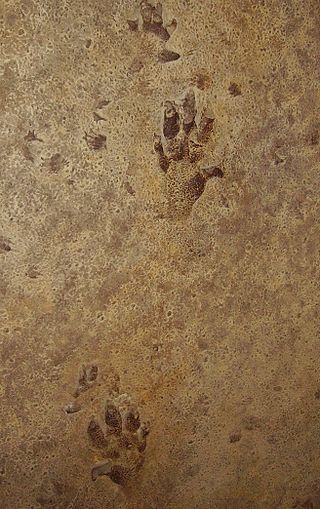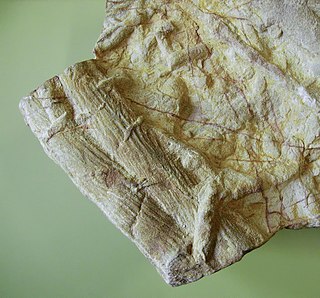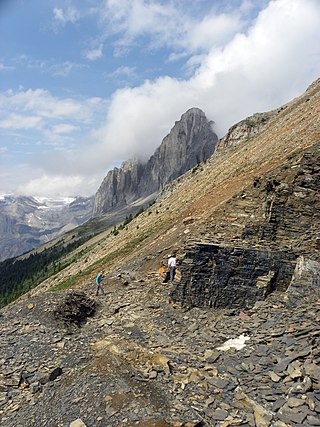
The Cambrian Period is the first geological period of the Paleozoic Era, and of the Phanerozoic Eon. The Cambrian lasted 53.4 million years from the end of the preceding Ediacaran Period 538.8 million years ago (mya) to the beginning of the Ordovician Period 485.4 mya. Its subdivisions, and its base, are somewhat in flux.

A trace fossil, also known as an ichnofossil, is a fossil record of biological activity by lifeforms but not the preserved remains of the organism itself. Trace fossils contrast with body fossils, which are the fossilized remains of parts of organisms' bodies, usually altered by later chemical activity or mineralization. The study of such trace fossils is ichnology and is the work of ichnologists.

Rangea is a frond-like Ediacaran fossil with six-fold radial symmetry. It is the type genus of the rangeomorphs.
Trace fossils are classified in various ways for different purposes. Traces can be classified taxonomically, ethologically, and toponomically, that is, according to their relationship to the surrounding sedimentary layers. Except in the rare cases where the original maker of a trace fossil can be identified with confidence, phylogenetic classification of trace fossils is an unreasonable proposition.
The Kaili Formation(凯里組) is a stratigraphic formation which was deposited during the Lower and Middle Cambrian. The formation is approximately 200 metres (660 ft) thick and was named after the city Kaili in the Guizhou province of southwest China.

The Ediacaranbiota is a taxonomic period classification that consists of all life forms that were present on Earth during the Ediacaran Period. These were enigmatic tubular and frond-shaped, mostly sessile, organisms. Trace fossils of these organisms have been found worldwide, and represent the earliest known complex multicellular organisms. The term "Ediacara biota" has received criticism from some scientists due to its alleged inconsistency, arbitrary exclusion of certain fossils, and inability to be precisely defined.

Paleodictyon is a trace fossil, usually interpreted to be a burrow, which appears in the geologic marine record beginning in the Precambrian/Early Cambrian and in modern ocean environments. Paleodictyon were first described by Giuseppe Meneghini in 1850. The origin of the trace fossil is enigmatic and numerous candidates have been proposed.

Cruziana is a trace fossil consisting of elongate, bilobed, approximately bilaterally symmetrical burrows, usually preserved along bedding planes, with a sculpture of repeated striations that are mostly oblique to the long dimension. It is found in marine and freshwater sediments. It first appears in upper Fortunian rocks of northern Iran and northern Norway. Cruziana has been extensively studied because it has uses in biostratigraphy, and because the traces can reveal many aspects of their makers' behavior.

Skolithos is a common trace fossil ichnogenus that is, or was originally, an approximately vertical cylindrical burrow. It is produced by a variety of organisms in shallow marine environments globally and appear as lineated features in sedimentary rocks.
The Burgess Shale of British Columbia is famous for its exceptional preservation of mid-Cambrian organisms. Around 69 other sites have been discovered of a similar age, with soft tissues preserved in a similar, though not identical, fashion. Additional sites with a similar form of preservation are known from the Ediacaran and Ordovician periods.

The "Cambrian substrate revolution" or "Agronomic revolution", evidenced in trace fossils, is a sudden diversification of animal burrowing during the early Cambrian period.
A number of assemblages bear fossil assemblages similar in character to that of the Burgess Shale. While many are also preserved in a similar fashion to the Burgess Shale, the term "Burgess Shale-type fauna" covers assemblages based on taxonomic criteria only.
Ediacaran type preservation relates to the dominant preservational mode in the Ediacaran period, where Ediacaran organisms were preserved as casts on the surface of microbial mats.

The Stephen Formation is a geologic formation exposed in the Canadian Rockies of British Columbia and Alberta, on the western edge of the Western Canada Sedimentary Basin. It consists of shale, thin-bedded limestone, and siltstone that was deposited during Middle Cambrian time. It is famous for the exceptional preservation of soft-bodied fossils: the Burgess Shale biota. The formation overlies the Cathedral escarpment, a submarine cliff; consequently it is divided into two quite separate parts, the 'thin' sequence deposited in the shallower waters atop the escarpment, and the 'thick' sequence deposited in the deeper waters beyond the cliff. Because the 'thick' Stephen Formation represents a distinct lithofacies, some authors suggest it warrants its own name, and dub it the Burgess Shale Formation. The stratigraphy of the Thin Stephen Formation has not been subject to extensive study, so except where explicitly mentioned this article applies mainly to the Thick Stephen Formation.

Helminthopsis is the ichnogenus of a type of trace fossil that is found preserved on the bedding planes of fine-grained sedimentary rocks. It is characterized by short, curvilinear, non-branching, parallel-sided, unlined traces on bedding surfaces. It is thought to represent the submarine feeding trails of an invertebrate organism that worked the surface of muddy substrates in search of food. Because Helminthopsis traces never cross over themselves, the ichnogenus is distinguished from similar traces assigned to the Gordia ichnogenus. The similar sounding, but now obsolete, ichnogenus Helminthoida refers to a somewhat similar trace characterized by regular, back-and-forth meanders, whereas Helminthopsis traces are irregular.

Haplotichnus is an ichnogenus of invertebrate trace fossil that was erected by S.A. Miller in 1889. Buatois et al. (1998) proposed that Haplotichnus should be synonymized with Gordia because both exhibit a looping course with self-crossing. Other researchers, such as Wang et al. (2009), have maintained the distinction between the two ichnogenera because Haplotichnus has sharp bends, whereas those of Gordia are not sharp. Most recently, Getty and Bush (2016) synonymized Haplotichnus with Treptichnus due to the presence of bifurcating projections at the bends. Other features, such as the looping course of the trace, thought to distinguish Haplotichnus from Treptichnus, are actually seen in one of the syntypes of Treptichnus, further supporting Getty and Bush's (2016) synonymy.

Chondrites is a trace fossil ichnogenus, preserved as small branching burrows of the same diameter that superficially resemble the roots of a plant. The origin of these structures is currently unknown. Chondrites is found in marine sediments from the Cambrian period of the Paleozoic onwards. It is especially common in sediments that were deposited in reduced-oxygen environments.

Maotianshania cylindrica is an extinct worm-like creature of average size. It occurs in the Lower Cambrian (Atdabanian) Chengjiang biota of Northeastern Yunnan, China. It is usually preserved as pink impression. The gut is a dark central zone. The anterior pharnyx and "collar", carry tiny sepia-colored teeth. The very back-end of the body has two small hooks.
Anthony J. Martin is a paleontologist who has taught at Emory University since the early 1990s. He is best known for his books, An Introduction to the Study of Dinosaurs, Life Traces of the Georgia Coast and Dinosaurs without Bones He is married to artist Ruth Schowalter.

Matgrounds are strong surface layers of seabed-hardening bacterial fauna preserved in the Proterozoic and lower Cambrian. Wrinkled matgrounds are informally named "elephant skin" because of its wrinkled surface in the fossil record. Matgrounds supported themselves until early burrowing worms were ubiquitous enough to unharden them. Burrowing animals broke down the hardy mats to further penetrate the underlying sediment for protection and feeding. Once matgrounds disappeared, exceptional preservation of lagerstätten such as the Burgess Shale or Ediacara Hills also did so too. Trace fossils such as Treptichnus are evidence for soft-bodied burrowers more anatomically complex than the Ediacaran biota that also caused the matgrounds disappearance.













